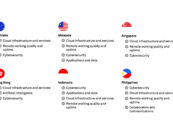Digital transformation is now everywhere, as every industry is actively adopting advanced information and communications technology (ICT) while changing business practices. The digital economy is extending its presence with speed, ease of access, as well as the power penetration that continuously change the behaviors of consumers and enterprises.
Such changes complicate the relations between supply and demand, making the market more segmented, diversified, whereas services and products are more personalized. That means organizations must reallocate their resources, and most importantly, rebuild their technological infrastructure to facilitate the pressing needs of agility and scalability.
From IoT to BoT
“Internet of Things”, or “IoT”, has been a buzz phrase, reflecting the integration of technologies in artificial intelligence (AI), mobility, 5G, big data and so on. Essentially, it is a network where things are interconnected, which makes tracking, location, identification, monitoring, as well as management, much more correlated.

Bank Service Ecosystem, Huawei’s Next Generation Financial Infrastructure Bank of Things White Paper
But “IoT”, intuitively, is seen to be involved in the tangibles, and financial services industry does not seem to have any direct association with it. Moreover, usually considered conservative, financial institutions like banks may not easily engage in the wave where technologies are the initiatives, given the complexity of governance and compliance that the gatekeepers are not opening the doors quickly.
Still, many banks are looking for various combinations of technology to reshape their operating models as the digital economy is extending its presence and here we have “Bank of Things”, or “BoT”.
Early on, BoT was conceived as the material infrastructure that facilitates the billions of data transfers that take place every day. It could facilitate data collection and sharing for insurance companies, instant contactless payments, or provide a framework for retail banks to collect information on customers. However, BoT could go way beyond that.
At HUAWEI CONNECT 2020 in September, Huawei and Shanghai Pudong Development Bank, jointly released the Bank of Things White Paper, redefining the financial service model, building on the concept of IoT and the related technologies.
Connecting humans and things
BoT is defined as “a business form in which ‘things’ become one of the core production materials of future banks and a component of the next-generation financial infrastructure with pan financial service capabilities,” which “things” refer to physical entities that directly engage in financial activities. Giving thanks to AI, “things” become more intelligent, where they will be able to make decisions autonomously, and likely to engage with humans via different social activities. Therefore, these “intelligent things” are expected to sense with its capability of environment awareness; they can express, think and memorize via information interaction, processing and storage. Ultimately they can identify with the capability of ownership proving. It won’t be at all surprising where “things” can independently own bank accounts and become direct banking service receivers, that are the customers.
Business models covering various scenarios
Despite the transformation that banks can serve “things” in general, customers still have their utmost importance of the financial service industry. The sector looks to tailor-make products and services for customers under specific scenarios and it is exceptionally useful in building such scenario centric business models.
With BoT, commercial banks, for instance, can proactively provide services to customers by identifying scenarios and analyzing their requirements using the massive data available. Customers will then receive faster services with customized advice before they realize their needs.
This is a critical for personalized services, especially when BoT is more than just about people but also “intelligent things”. Through this, banks can interact with customers, detect their experience and know their requirements by embedding services into production and real-life scenarios. Customers can then see their demands better addressed with more precise services.
Financial services available anytime, anywhere
With the decreasing reliance on humans, the Bank of Things allows comprehensive services round the clock and unrestricted on locations. For example, a bank can easily approve your loan application at 2 a.m. when you are at the other end of the globe, as long as you have your smart device with you to keep you connected.
Other services like renewing licenses or receiving funds can be done anytime. That means “business hours” will become meaningless, as the world can continuously operate with the support of AI, connectivity and other innovative technologies.
Amid these transactions, BoT can also detect real-time customer behavior in specific scenarios using various devices. Human beings may not be as involved in the service chain. Still, they are ultimately enjoying the advancement of services anytime, anywhere, thanks to the integrated pan-financial services supported by the likes of big data and associated analysis.
Enhanced risk management model on an enhanced data credit system
Risk management is sometimes overlooked in the course of digital transformation. AI is more frequently applied in assessing customers’ credit background, for instance, among banks for loan or mortgage. Some leverage the technology to come up with different loan products for the benefits of both ends.
By utilizing technologies including big data, cloud computing, mobile network, and of course IoT, BoT can run a risk management toolbox using objective data – the combination of subject credit, transaction credit and entity credit. As things are intelligently connected, the toolbox can quickly start with customers’ necessary information and go through the process by carefully contain risks along each stage of data analysis. The new risk management model may enrich credit data sources, improves data credibility, and allows more natural and legal persons to enjoy financial rights, facilitating financial inclusion.
Bot goes beyond future
The concept of Bank of Things demonstrates a new financial infrastructure that is futuristic and visionary, yet enormously pragmatic in the era of a digital and intelligent society. While the Internet of Things reshapes economy by changing the interactions between supply and demand, BoT takes the transformation to yet another level by giving “intelligent things” the financial capabilities. Customers can also be served with a broader range of products and services without the limitation of time and location. For banks, this turns pan-financial service capabilities into one of the core parameters of competitiveness.
Shanghai Pudong Development Bank and Huawei have shared more insights in the White Paper. In additions of how this BoT concept can extend service targets beyond people to “intelligent things”, as well as the business scenarios and the enhanced risk management model based on an objective credit system, the White Paper also details on BoT business forms, the related architecture, and the scenario design in the digital economy. There are more about possible technical challenges, the expectations for pan-financial services and a new digital credit system.
Along with the lender, Huawei set up a lab for innovation in 2018, and the results have been fruitful. In 2020, Huawei signed a deal with the bank to explore more option such as improving user experience, leveraging digital technologies, and driving the innovation of industries like retail, communications, transportation, and healthcare, and ultimately creating a thriving digital economy.
Shanghai Pudong Development Bank was incorporated on January 9, 1993, with the approval of the People’s Bank of China on August 28, 1992. It is a national joint-stock commercial bank headquartered in Shanghai. Shanghai Pudong Development Bank has built up a nationwide commercial bank operation and service network consisting of 41 branches employees. To find out more about Bank of Things and what Huawei does to drive this change, please visit here.
Featured image: edited from freepik





